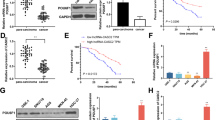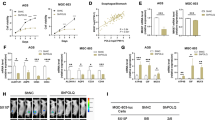Abstract
Recent studies revealed that NOP2/Sun RNA methyltransferase 5 (NSUN5) - ferritin heavy chain (FTH1) pathway is associated with ferroptosis in stem cells, whereas its roles in gastric cancer are still unclear. Our study aims to investigate the roles of the NSUN5-FTH1 axis in gastric cancer (GC) and its molecular mechanisms. Stable cell lines were constructed on SGC7901 cells by using shRNAs and pcDNA3.1 expression vectors, respectively. CCK-8 kits were used to determine cell viability. Biochemicals assays were used to detect lipid reactive oxygen species (ROS) and intracellular Fe2+ levels. RNA immunoprecipitation assay, qPCR, and Western blotting were used to determine the changes in biomarkers. GC xenograft mouse model was established to confirm the observation in vivo. An elevation of NSUN5 was observed in GC tumor tissues. NSUN5 inhibited ferroptosis including decreasing cell viability and increasing levels of lipid ROS and Fe2+ in GC cells. Besides, a positive correlation was also observed between NSUN5 and FTH1. Interestingly, NSUN5 regulated the levels of FTH1, instead of FTH1 regulating NSUN5 in GC cells. NSUN5-FTH1 axis regulated erastin-induced ferroptosis in SGC7901 cells. Consistently, silencing NSUN5 or FTH1 inhibited the growth of the SGC7901 tumor in vivo. NSUN5-FTH1 axis promoted the growth of GC cells in part by the regulation of ferroptosis.





Similar content being viewed by others
Data Availability
The raw data supporting the conclusions of this article will be made available by the authors, without undue reservation.
References
Van Cutsem, E., Sagaert, X., Topal, B., Haustermans, K., & Prenen, H. (2016). Gastric cancer. The Lancet, 388(10060), 2654–2664.
Rawla, P., & Barsouk, A. (2019). Epidemiology of gastric cancer: global trends, risk factors and prevention. Przegląd Gastroenterologiczny, 14(1), 26–38.
Ushijima, T., & Sasako, M. (2004). Focus on gastric cancer. Cancer Cell, 5(2), 121–125.
Crew, K. D., & Neugut, A. I. (2006). Epidemiology of gastric cancer. World Journal of Gastroenterology: WJG, 12(3), 354.
Peng, C., Kang, W., & Li, Y. (2022). Respiratory chain complex I is related to oxidative phosphorylation in gastric cancer stem cells. STEMedicine, 3(2), e123.
Kong, W.-J., Liu, W.-D., Wang, M., Hui, W.-J., & Gao, F. (2022). Modulation of cisplatin resistance in gastric cancer by LncRNA SNHG15. STEMedicine, 3(3), e137.
Wang, H., Liu, M., Zeng, X., Zheng, Y., Wang, Y., & Zhou, Y. (2022). Cell death affecting the progression of gastric cancer. Cell Death Discovery, 8(1), 377.
Alzeeb, G., Arzur, D., Trichet, V., Talagas, M., Corcos, L., & Le Jossic-Corcos, C. (2022). Gastric cancer cell death analyzed by live cell imaging of spheroids. Scientific Reports, 12(1), 1488.
Li, J., Cao, F., Yin, H. L., Huang, Z. J., Lin, Z. T., Mao, N., et al.(2020). Ferroptosis: past, present and future. Cell Death & Disease, 11(2), 88.
Cao, J. Y., & Dixon, S. J. (2016). Mechanisms of ferroptosis. Cellular and Molecular Life Sciences, 73(11-12), 2195–2209.
Bebber, C. M., Muller, F., Prieto Clemente, L., Weber, J., & von Karstedt, S. (2020). Ferroptosis in cancer cell biology. Cancers (Basel), 12(1), 164.
Hassannia, B., Vandenabeele, P., & Vanden Berghe, T. (2019). Targeting ferroptosis to iron out cancer. Cancer Cell, 35(6), 830–849.
Yu, H., Guo, P., Xie, X., Wang, Y., & Chen, G. (2017). Ferroptosis, a new form of cell death, and its relationships with tumourous diseases. Journal of Cellular and Molecular Medicine, 21(4), 648–657.
Hao, S., Yu, J., He, W., Huang, Q., Zhao, Y., Liang, B., et al. (2017). Cysteine dioxygenase 1 mediates erastin-induced ferroptosis in human gastric cancer cells. Neoplasia., 19(12), 1022–1032.
Zhao, L., Peng, Y., He, S., Li, R., Wang, Z., Huang, J., et al. (2021). Apatinib induced ferroptosis by lipid peroxidation in gastric cancer. Gastric Cancer, 24(3), 642–654.
Ma, M., Kong, P., Huang, Y., Wang, J., Liu, X., Hu, Y., et al. (2022). Activation of MAT2A-ACSL3 pathway protects cells from ferroptosis in gastric cancer. Free Radical Biology and Medicine, 181, 288–299.
Liu, J., Ren, Z., Yang, L., Zhu, L., Li, Y., Bie, C., et al. (2022). The NSUN5-FTH1/FTL pathway mediates ferroptosis in bone marrow-derived mesenchymal stem cells. Cell Death Discovery, 8(1), 99.
Song, Y., Yang, H., Lin, R., Jiang, K., & Wang, B. M. (2019). The role of ferroptosis in digestive system cancer. Oncology Letters, 18(3), 2159–2164.
Gao, M., Yi, J., Zhu, J., Minikes, A. M., Monian, P., Thompson, C. B., et al. (2019). Role of mitochondria in ferroptosis. Molecular Cell, 73(2), 354–363.e3.
Yang, H., Wang, J., Fan, J.-H., Zhang, Y.-Q., Zhao, J.-X., Dai, X.-J., et al. (2017). Ilexgenin A exerts anti-inflammation and anti-angiogenesis effects through inhibition of STAT3 and PI3K pathways and exhibits synergistic effects with Sorafenib on hepatoma growth. Toxicology and Applied Pharmacology, 315, 90–101.
Chen, X., Kang, R., Kroemer, G., & Tang, D. (2021). Broadening horizons: the role of ferroptosis in cancer. Nature Reviews Clinical Oncology, 18(5), 280–296.
Chen, P., Zhang, T., Yuan, Z., Shen, B., & Chen, L. (2019). Expression of the RNA methyltransferase Nsun5 is essential for developing cerebral cortex. Molecular Brain, 12(1), 1–14.
Rosselló-Tortella, M., Llinàs-Arias, P., Sakaguchi, Y., Miyauchi, K., Davalos, V., Setien, F., et al. (2020). Epigenetic loss of the transfer RNA-modifying enzyme TYW2 induces ribosome frameshifts in colon cancer. Proceedings of the National Academy of Sciences, 117(34), 20785–20793.
Zhang, X.-W., Huang, Y., Wu, L.-Y., Qi, Q., Zhong, R., Lim S.-S., et al. (2020) NSUN5 is upregulated and positively correlated with translation in human cancers: a bioinformatics-based study. https://doi.org/10.21203/rs.3.rs-92585/v1.
Liu, F., Du, Z. Y., He, J. L., Liu, X. Q., Yu, Q. B., & Wang, Y. X. (2012). FTH1 binds to Daxx and inhibits Daxx-mediated cell apoptosis. Molecular Biology Reports, 39(2), 873–879.
Fang, Y., Chen, X., Tan, Q., Zhou, H., Xu, J., & Gu, Q. (2021). Inhibiting ferroptosis through disrupting the NCOA4–FTH1 interaction: a new mechanism of action. ACS Central Science, 7(6), 980–989.
Tian, Y., Lu, J., Hao, X., Li, H., Zhang, G., Liu, X., et al. (2020). FTH1 inhibits ferroptosis through ferritinophagy in the 6-OHDA model of Parkinson’s disease. Neurotherapeutics, 17(4), 1796–1812.
Muhammad, J. S., Bajbouj, K., Shafarin, J., & Hamad, M. (2020). Estrogen-induced epigenetic silencing of FTH1 and TFRC genes reduces liver cancer cell growth and survival. Epigenetics, 15(12), 1302–1318.
Author information
Authors and Affiliations
Contributions
All authors contributed to the study conception and design. Material preparation, data collection and analysis were performed by J.L., Z.Z., L.S., W.H., X.H., C.Y., J.Q., W.W., H.Z. The first draft of the manuscript was written by Y.S. All authors read and approved the final manuscript.
Corresponding author
Ethics declarations
Conflict of interest
The authors declare no competing interests.
Consent to publish
Current study is available from the corresponding author on reasonable request.
Ethical approval
The study was approved by the ethics committee of Quanzhou First Hospital, affiliated to Fujian Medical University. This study was performed in strict accordance with the NIH guidelines for the care and use of laboratory animals (NIH Publication No. 85-23 Rev. 1985).
Additional information
Publisher’s note Springer Nature remains neutral with regard to jurisdictional claims in published maps and institutional affiliations.
Supplementary information
Rights and permissions
Springer Nature or its licensor (e.g. a society or other partner) holds exclusive rights to this article under a publishing agreement with the author(s) or other rightsholder(s); author self-archiving of the accepted manuscript version of this article is solely governed by the terms of such publishing agreement and applicable law.
About this article
Cite this article
Su, Y., Liu, J., Zheng, Z. et al. NSUN5-FTH1 Axis Inhibits Ferroptosis to Promote the Growth of Gastric Cancer Cells. Cell Biochem Biophys 81, 553–560 (2023). https://doi.org/10.1007/s12013-023-01152-1
Received:
Accepted:
Published:
Issue Date:
DOI: https://doi.org/10.1007/s12013-023-01152-1




